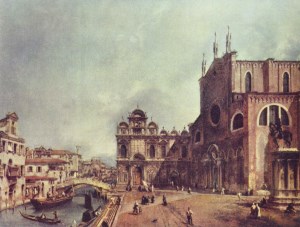
Capitalism is an economic system wherein private owners control industry, and trade goods and services to make a profit. Capitalism originated in Western Europe and spread for years until it engulfed the whole continent. In the early modern world (1500-1800), Europe dominated the globe economically due to colonialist exploration of western lands and eastern trade routes. Those European traders were merchant capitalists.
In 1492, Venice and the Hanseatic League – a commercial alliance of merchants made up of several European countries including Germany, the Netherlands, Poland and the UK –were the dominant economic powers of Europe. Both controlled many trade routes, and Venice had a monopoly on the spice trade. In the early 1500s, Portuguese ships carrying spices from the East Indies arrived in the Flemish city of Antwerp, breaking the Venetian monopoly. Hanseatic merchants also faced competition from Flemish and English merchants. Soon, Antwerp was the new center of international trade.
Merchants and financers filled Antwerp, and ships with diverse cargo came and went from all over the globe. In 1557, however, Spain’s bankruptcy irrevocably damaged Antwerp’s banking system. While Antwerp was dragged into the religious wars of the Netherlands, the Italian city of Genoa became the leading financial center of Europe. In the early 1600s, the center of trade changed again, from Genoa to Amsterdam. There, a flexible and stable banking system had developed following the massive migration of bankers and merchants from Antwerp in 1585, benefiting Amsterdam economically. Along with their huge merchant fleet, Dutch seafaring skills, and abundant cheap energy from windmills and peat, Amsterdam – and by extension, the Netherlands – took over Asian and European trade.
Years later, during the late 1600s, a strong rivalry developed between the Netherlands and England. Both countries were eager to keep the riches from their colonies in the Americas within their own grasp. These tensions rose until three wars erupted between the English and Dutch. The Dutch won two of the three wars with its formidable armada, proving to have the strongest navy in Europe.
Although France tried to emulate the Dutch and English and reach economic supremacy, the country could not achieve its goal. France arrived to the race for colonies too late, and unlike the Dutch and English, was unable to commercialize in manufacturing and agriculture.
By the late 1680s, the Dutch economy idled, while the English economy benefited from both a large overseas investment and a flood of Huguenot (French Protestant) refugees. The refugees had expertise in brewing, papermaking, ceramics, glass making and silk weaving, which helped England’s economy.
Britain succeeded in industrialization where the Netherlands failed. Britain was able to use coal as a new and abundant energy source, invent the steam engine as a source of mechanical power and, in the 1770s, mechanize the textile industry. This led to the construction of the first factories and what was only the beginning of industrialized production. The Dutch, while successful in the age of merchant capitalism, required a bigger population and more natural resources to industrialize.
By looking at the development of factories and the start of industrialized production, historians can see how merchant capitalism gave way to the industrial capitalism present in the world today. Perhaps one day, modern industrial capitalism will, in turn, give way to a new type of capitalism, and future historians will look back at today’s developments and learn from the industrial era.
[Source:
A Short History of the World
]

